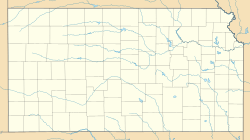Bernhard Warkentin Homestead facts for kids
|
Bernhard Warkentin Homestead
|
|
| Location | E. North St., Halstead, Kansas |
|---|---|
| Area | 12 acres (4.9 ha) |
| Built | 1874 |
| Architect | Haskell, John Gideon |
| Architectural style | Queen Anne |
| NRHP reference No. | 74000839 |
Quick facts for kids Significant dates |
|
| Added to NRHP | February 15, 1974 |
| Designated NHL | December 14, 1990 |
The Bernhard Warkentin Homestead is a special historic farm in Halstead, Kansas. It is also known as the Little River Stock Farm or Warkentin Farm. This farm was added to the National Register of Historic Places in 1974.
Later, in 1990, it became a National Historic Landmark. This means it is very important to the history of the United States. The farm is famous because of Bernhard Warkentin. He played a big part in growing a special type of wheat called durum wheat across the country.
Contents
What is the Bernhard Warkentin Homestead?
The Warkentin Farm is located on the north side of Halstead. It sits on the east side of Main Street, near East North Street. The property covers about 12 acres (about 4.8 hectares).
Railroad tracks are to the south of the farm. The Arkansas River runs along its north and east sides. A grain elevator is located to the west. The main farm buildings are grouped together on the western part of the land. Fields stretch out to the east.
Buildings at the Farm
The farm has several important buildings. These include the main house, a carriage house, and a barn. There is also a silo and a small pump house. The main house is a large, two-and-a-half-story building. It is made of wood.
The house was built in 1884. A famous Kansas architect named John G. Haskell designed it.
Who was Bernhard Warkentin?
Bernhard Warkentin was an immigrant from Ukraine. His family had German roots. He moved to the United States from Russia in 1872. In Russia, his family worked with wheat. They grew it and processed it into flour.
Warkentin was a leader for many Mennonite families. These families wanted to move from Russia to the United States. In 1874, Warkentin bought over 1,300 acres of land. He built his home and a mill on this land. He also helped other German Mennonites settle in the area.
Warkentin's Impact on Farming
Bernhard Warkentin and the Mennonites brought important farming knowledge with them. They knew about special kinds of hard wheat from Russia. They brought these wheat varieties to America when they first arrived.
In 1896, Warkentin started working with Mark Carleton. Carleton was from the United States Department of Agriculture. They wanted to learn more about Russian wheat. Their work led to new experiments. These experiments created durum wheat. Today, durum wheat is one of the most important wheat crops in the United States.



